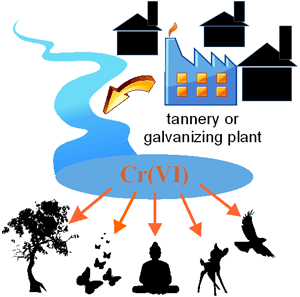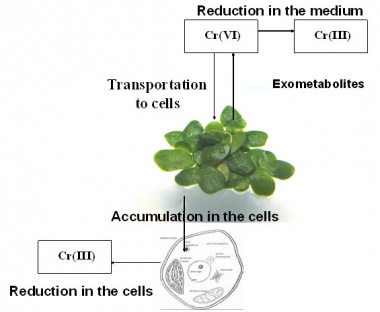The development of biotechnology for water purification from toxic hexavalent chromium by duckweed plants (Lemna minor L.)
m (→Reduction of Cr(VI) to Cr(III) in plant cells and medium) |
|||
| Line 21: | Line 21: | ||
</div> | </div> | ||
<div style='margin-right:10px;float:left;width:550px;height:400px;'> | <div style='margin-right:10px;float:left;width:550px;height:400px;'> | ||
| − | ===Lemna plants | + | ===Lemna plants growth under Cr(VI) induced stress=== |
[[Image:Lemna plants growht under Cr(VI) indused stress.jpg|550px]] | [[Image:Lemna plants growht under Cr(VI) indused stress.jpg|550px]] | ||
* Duckweed plants survive in a medium containing Cr(VI) in concentration up to 4mM. | * Duckweed plants survive in a medium containing Cr(VI) in concentration up to 4mM. | ||
Revision as of 09:38, 21 September 2015
Laboratory of Adaptative Biotechnology
The problem of environmental pollution
As chromium compounds were used in dyes and paints and the tanning of leather, these compounds are often found in soil and groundwater at abandoned industrial sites, now needing environmental cleanup and remediation per the treatment of brownfield land. Primer paint containing hexavalent chromium is still widely used for aerospace and automobile refinishing applications.
World Health Organization recommended maximum allowable concentration in drinking water for Cr (VI) is 0.05 mg/l.
Lemna plants growth under Cr(VI) induced stress
- Duckweed plants survive in a medium containing Cr(VI) in concentration up to 4mM.
- Increasing of Cr(VI) concentration up to 8 mM is critical: plants die but can reduce toxic Cr(VI) to nontoxic Cr(III) by plant metabolites
Decreasing of Cr(VI) concentration in the medium
Massive plant mortality explains the violation of this law for L.minor cultivation on 8 mM of initial chromium (VI) concentration.
Plants can not completely reduce chromium (VI) in such conditions but decreases it concentration eight times.
During the Cr(VI) reduction its concentration in cultivation medium decreases linearly.
1 mM -> 0 - after 5 days of duckweed growth (predicted) 1,5 mM -> 0 - after 6 days of duckweed growth (measured) 2 mM -> 0 - after 7 days of duckweed growth (predicted) 4 mM -> 0 - after 10 days of duckweed growth (measured)







